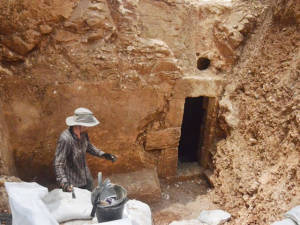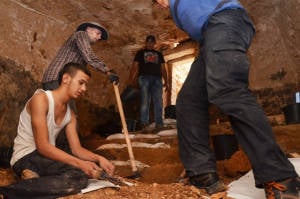
The front of the cave as exposed in the excavation. (Shai Halevy/IAA)
Time and again, the Land of Israel reveals its hidden treasures testifying to its Jewish history. This time, an ancient ritual bath with mysterious inscriptions and pictures was found in Jerusalem.
A “unique and most intriguing” discovery that has fired archaeologists’ imagination was exposed by chance about two months ago during a routine excavation in Jerusalem
The Israel Antiquities Authority (IAA), which went public with the news on Wednesday, said the archaeological discovery was found at the Arnona neighbourhood during a routine inspection by the IAA of a construction site of a nursery school being built in the Jerusalem.
The excavation revealed an impressive ritual bath (mikvah) dating to the time of the Second Temple (first century CE) inside an underground cave. An anteroom, flanked by benches, led to the bath. A wine press was found alongside the ritual bath.
The walls of the mikvah were covered with ancient plaster and adorned with numerous wall paintings and inscriptions, written in mud, soot and by incising. The inscriptions are Aramaic and written in cursive Hebrew script, which was customary at the end of the Second Temple period. Among the symbols that are drawn are a boat, palm trees and various plant species, and possibly even a menorah.
Royee Greenwald and Alexander Wiegmann, excavation directors on behalf of the IAA, said “there is no doubt that this is a very significant discovery. Such a concentration of inscriptions and symbols from the Second Temple period at one archaeological site, and in such a state of preservation, is rare and unique and most intriguing.”
Mysterious Inscriptions
At this point in the research the inscriptions are a mystery, the IAA said. Some of the inscriptions may indicate names.
The symbols on the walls are common elements in the visual arts of the Second Temple period. In the meantime, the drawing that might possibly be construed as a menorah is exceptional because in those days they abstained from portraying this sacred object which was located in the Temple. According to the excavators, “on the one hand the symbols can be interpreted as secular, and on the other as symbols of religious significance and deep spirituality.”

Exposing the steps of the ritual bath. (Shai Halevy/IAA)
A number of issues and questions now face the researchers: What is the relationship between the symbols and the inscriptions, and why, of all places, were they drawn in the ritual bath? Who is responsible for painting them? Was it one person or several people? Was it someone who jokingly wanted to scribble graffiti, or perhaps what we have here is a desire to convey a deeply spiritual and religious message, perhaps even a cry for help as a result of a traumatic event such as the destruction of the Second Temple and the catastrophic war of 66-70 CE?
The wall paintings are so sensitive that their exposure to the air causes damage to them. As soon as the inscriptions were discovered the IAA began implementing complex conservation measures. They underwent initial treatment at the site, were removed in their entirety from the ritual bath, and transferred to the conservation laboratories of the IAA for further treatment and stabilization.
The Israel Antiquities Authority will display the spectacular inscriptions to the general public, it stated.
Moshe Tur-Paz, head of the Education Administration at the Jerusalem Municipality, who is in charge of the construction of the nursery, said that “the archaeological and historical site that was exposed is of tremendous value to our identity as a Jewish people, which might shine more light on the lives of our ancestors in the city of Jerusalem. We will maintain contact with the Israel Antiquities Authority and together we will examine how we can give educational and symbolic expression to the discovery that was found.”
Occurrences such as coming across ancient relics by chance in Israel are almost routine. In July, an ancient, 2,000-year-old mikvah was discovered by chance in Jerusalem below a living room floor during home renovations. In June, the upgrading and widening of the highway connecting Jerusalem to Tel Aviv has led to the discovery of a large Byzantine-era road station and church on the ancient route. In February 2014, the remnants of a rural town that was lived in for some two centuries during the Second Temple period were uncovered near the main route to Jerusalem under similar circumstances, when a main gas line was being installed.
By: Max Gelber, United with Israel
With files from the Ministry of Foreign Affairs

Free Ebook: 10 Best Places to Visit in Israel
The Land of Israel has provided the backdrop for some of the most important events in human history. From the Old City in Jerusalem to the Sea of Galilee, people from all over the globe visit the Holy Land each year to take in the breathtaking scenery and inspiration of Israel. Now you can experience this beauty for yourself from the comforts of home and maybe plan a trip of your own to Israel. Get the free, exclusive eBook from United with Israel: The 10 Best Places to Visit in Israel.
